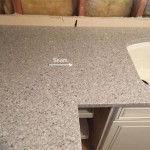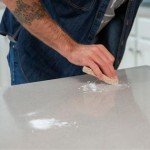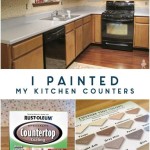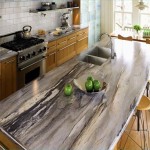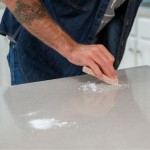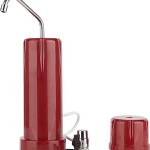How To Cover A Countertop
Countertops are subjected to a great deal of wear and tear. From spills and scratches to heat and stains, these surfaces endure daily abuse. Replacing a countertop can be expensive and disruptive, making covering or resurfacing a viable alternative. Several methods can be employed to cover a countertop, each with its own advantages and disadvantages. The choice depends on the desired aesthetic, budget constraints, and the level of durability required.
This article will explore various options for covering a countertop. It will delve into the materials suitable for this purpose, outline the steps involved in each approach, and discuss the pros and cons to help make an informed decision. Understanding these techniques can transform an outdated or damaged countertop into a visually appealing and functional surface.
Understanding the Existing Countertop
Before embarking on any countertop covering project, a thorough assessment of the existing surface is crucial. The type of material, its condition, and any existing damage will influence the choice of covering method and the preparatory steps required. Laminate, tile, solid surface, and even wood countertops present unique considerations.
If the existing countertop is laminate, inspect it for chips, cracks, or peeling. Minor imperfections can often be concealed with the new covering, but significant damage may necessitate repairs or even a complete replacement of the underlying substrate. Similarly, tiled countertops should be examined for loose or cracked tiles, as well as damaged grout. Solid surface countertops, like Corian, are generally more durable but can still be susceptible to scratches and stains.
Regardless of the material, cleaning the countertop thoroughly is paramount. Remove any grease, grime, or debris that could impede adhesion. A degreasing cleaner followed by a rinse with clean water is typically sufficient. Allow the surface to dry completely before proceeding with any further steps. Proper preparation directly impacts the success and longevity of the countertop covering.
Exploring Covering Options: Contact Paper and Vinyl
Contact paper and vinyl offer cost-effective and relatively simple solutions for covering countertops. These materials are available in a wide array of colors, patterns, and textures, allowing for considerable design flexibility. They can mimic the appearance of more expensive materials, such as granite or marble, at a fraction of the cost.
Applying contact paper or vinyl involves several key steps. First, measure the countertop accurately and cut the material slightly larger than the required dimensions. This allows for trimming and adjustments during installation. Peel off a small portion of the backing paper and carefully align the contact paper or vinyl with one edge of the countertop. Use a smoothing tool, such as a plastic scraper or a rolling pin, to press the material onto the surface, working from the center outwards to eliminate air bubbles. Continue peeling off the backing paper and smoothing the material until the entire countertop is covered. Finally, trim any excess material with a sharp utility knife.
While contact paper and vinyl offer an attractive and affordable short-term solution, their durability is limited. They are susceptible to scratches, heat damage, and staining. They may also peel or bubble over time, particularly in areas with high moisture exposure, such as around the sink. These materials are therefore best suited for temporary upgrades or low-traffic areas.
Utilizing Epoxy Resin for a Durable Finish
Epoxy resin provides a more durable and aesthetically pleasing option for covering a countertop. This material creates a seamless, glossy surface that is resistant to scratches, stains, and heat. Epoxy resin can be tinted to any desired color and can also be embedded with decorative elements, such as glitter, stones, or metal flakes, to create a unique and personalized look.
Applying epoxy resin requires meticulous preparation. The existing countertop must be thoroughly cleaned and sanded to provide a textured surface for the epoxy to adhere to. Any imperfections, such as cracks or chips, should be filled with epoxy filler and sanded smooth. The surrounding areas should be covered with plastic sheeting to protect them from spills.
The epoxy resin is typically mixed in two parts: the resin and the hardener. The mixing ratio must be precise to ensure proper curing. Once mixed, the epoxy is poured onto the countertop and spread evenly using a squeegee or a notched trowel. Air bubbles can be removed by passing a heat gun or a propane torch over the surface. Multiple coats may be required to achieve the desired thickness and appearance. Each coat must be allowed to cure completely before applying the next.
Epoxy resin is a more expensive and time-consuming option than contact paper or vinyl, but it offers significantly greater durability and longevity. It is a suitable choice for those seeking a long-lasting and visually appealing countertop solution. It is important to note that working with epoxy resin requires proper ventilation and safety precautions, as the fumes can be harmful.
Exploring Alternative Materials: Tile and Concrete
Tile and concrete offer more permanent and substantial solutions for covering countertops. Tile provides a classic and durable surface that is resistant to heat, scratches, and stains. It is available in a vast array of colors, sizes, and materials, allowing for endless design possibilities. Concrete, on the other hand, offers a modern and industrial aesthetic and can be customized with various finishes and colors.
Installing tile involves applying a thin-set mortar to the existing countertop using a notched trowel. The tiles are then pressed into the mortar, ensuring proper spacing between each tile using spacers. Once the mortar has cured, the grout is applied to fill the spaces between the tiles. Excess grout is removed with a sponge, and the surface is cleaned thoroughly. Sealing the grout is essential to prevent staining and water damage.
Covering a countertop with concrete typically involves applying a thin layer of concrete overlay. The existing countertop must be properly prepared by cleaning, sanding, and applying a bonding agent. The concrete overlay is then mixed with water and applied to the surface using a trowel. The concrete is leveled and smoothed, and any desired texture or pattern can be added. Once the concrete has cured, it is sealed with a protective sealant to prevent staining and water damage.
Both tile and concrete are durable and long-lasting options, but they require more skill and effort to install than contact paper, vinyl, or epoxy resin. Tile can be prone to cracking if the underlying surface is unstable, and concrete can be susceptible to staining if not properly sealed. These materials are best suited for those seeking a permanent and substantial countertop solution.
Considerations for Edge Treatment
Regardless of the chosen covering material, careful attention must be paid to the edges of the countertop. The edges are particularly vulnerable to damage and can significantly impact the overall aesthetic. Several options are available for treating the edges, depending on the material being used and the desired look.
For contact paper and vinyl, the edges can be wrapped around the countertop and secured with adhesive. Alternatively, edge banding can be applied to create a clean and finished look. For epoxy resin, the edges can be coated with the same resin, creating a seamless and continuous surface. A drip edge can also be incorporated to prevent spills from running down the cabinets.
For tile countertops, bullnose tiles are specifically designed to create a rounded and finished edge. These tiles are installed along the edges of the countertop, providing a smooth and comfortable surface. For concrete countertops, the edges can be formed using plywood or melamine forms. The concrete is poured into the forms, creating a smooth and uniform edge. The edges can also be ground and polished to create a more refined look.
Proper edge treatment is essential for both aesthetic and functional reasons. It protects the edges from damage, prevents water from seeping under the covering material, and contributes to the overall finished appearance of the countertop.
Budget and Time Considerations
The cost and time required for covering a countertop can vary significantly depending on the chosen material and the scope of the project. Contact paper and vinyl are the least expensive and time-consuming options, while tile and concrete are the most expensive and labor-intensive. Epoxy resin falls somewhere in the middle in terms of both cost and time.
When budgeting for a countertop covering project, it is important to factor in the cost of materials, tools, and any professional labor that may be required. It is also important to consider the time required for preparation, installation, and curing. Some materials, such as epoxy resin and concrete, require significant curing time before the countertop can be used.
It is advisable to obtain multiple quotes from contractors before hiring someone to cover a countertop. Be sure to ask about their experience, qualifications, and insurance coverage. It is also important to review their portfolio of previous work to ensure that their style and quality meet expectations.
Maintenance and Care
Proper maintenance and care are essential for extending the life of a covered countertop. The specific maintenance requirements will vary depending on the material used.
Contact paper and vinyl countertops should be cleaned with a mild soap and water. Avoid using abrasive cleaners or scouring pads, as these can scratch or damage the surface. Epoxy resin countertops can be cleaned with a damp cloth or a mild detergent. Avoid using harsh chemicals or solvents, as these can damage the finish. Tile countertops should be cleaned with a tile cleaner and a grout brush. Sealing the grout regularly will help to prevent staining and water damage. Concrete countertops should be cleaned with a pH-neutral cleaner. Avoid using acidic cleaners, as these can etch the surface. Sealing the concrete regularly will help to prevent staining and water damage.
Protecting the countertop from heat and sharp objects is also important. Use trivets or hot pads under hot pots and pans, and use cutting boards when chopping or slicing food. Promptly wipe up any spills to prevent staining. With proper maintenance and care, a covered countertop can provide years of enjoyment.

Covering Existing Countertops With Granite Counter Overlay

How To Cover A Countertop With Contact Paper Craft Your Happiness

Covering Tile Countertops With Peel And Stick Marble Wallpaper Vinyl In Kitchen Without Lumps Youtube

How To Cover A Countertop With Contact Paper Craft Your Happiness

5 Quick Ways To Cover Kitchen Countertops Without Replacing Them Proline Range Hoods

How To Cover A Countertop With Contact Paper Craft Your Happiness

How To Cover Laminate Countertops With Tile 15 Steps

7 Excellent Kitchen Countertop Cover Ups

How To Cover Tile Countertops With Thin Quartz Granite Selection
Concrete Countertop Diy A Beautiful Mess
See Also

